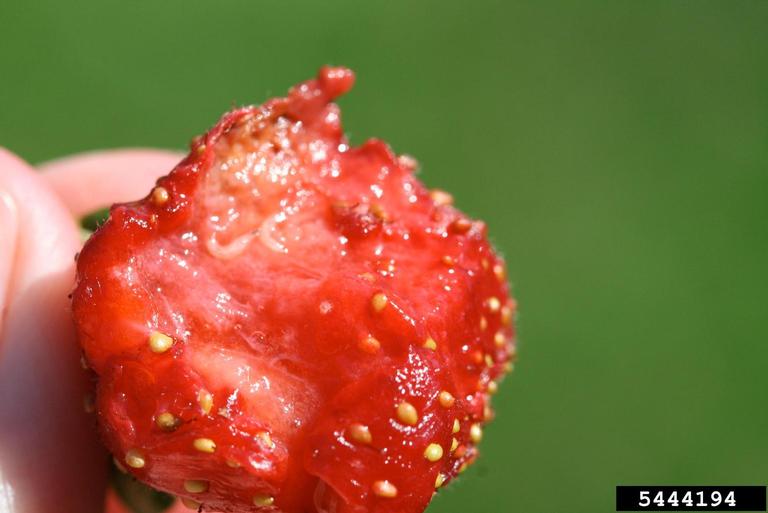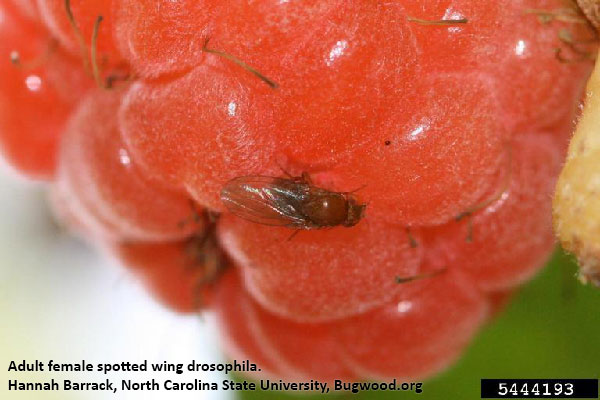Raspberries are a popular small fruit for Nebraska gardeners and usually pretty easy to grow. But recently a new challenge has appeared in the form of a small non-native fruit fly, called the spotted wing drosophila (SWD). Last summer some Nebraskan’s found their raspberries to be heavily affected by SWD.
There have always been fruit flies in Nebraska. Two native species include the cherry fruit fly and black cherry fruit fly which, as their name suggests, primarily attack fruits in the cherry family. These flies are the adult form of the common cherry maggots we find in fruit. The fruit fly most people are familiar with is Drosophila melanogaster, also called the common fruit fly, which attacks damaged or rotting fruits and vegetables of almost every type but is not a pest of healthy undamaged fruits. The common fruit fly is an introduced species native to the Old World, with the greatest diversity in tropical forests of Asia and central Africa.
Identification
SWD is another unwelcome introduction, coming from Japan and eastern Asia. SWD looks very similar to the common fruit fly – 1/8th inch long, tan body, red eyes and brown bands on their abdomens. Male SWD have a distinct black spot year the tip of each wing, giving the species its common name. Larvae are white legless maggots, 1/8th inch long.
 SWD larvae in strawberry. Hannah Barrack, North Carolina State University, Bugwood.org
SWD larvae in strawberry. Hannah Barrack, North Carolina State University, Bugwood.orgDamage
The biggest problem with SWD is females lay eggs in healthy, sound fruits as they ripen. Keeping fruits healthy and undamaged is not a deterrent. As ripening fruits become available in late spring and early summer, females make a slit in a fruit’s skin and insert several eggs. Each female deposits a dozen eggs per day, ultimately laying an estimated 300 eggs during her lifespan. There are multiple generations each summer. At an optimal temperature of 82° F, development from egg to adult can take place in just over one week, resulting in explosive population growth in late summer.
SWD has a definite preference on fruits they attack, with their primary targets being raspberry, blackberry, blueberry and strawberry. But they also attack cherry, plum, chokecherry (Prunus), chokeberry (Aronia), peach, apricot and grapes, in addition to wild and ornamental berry hosts, including elderberry, wild plum, currants, buckthorn, serviceberry, dogwood, snowberry, mulberry, pokeweed, black nightshade, groundcherry and asparagus. Tougher skinned fruits such as apple, pear and tomato can be infested, especially if they are damaged.
After egg-laying, the wounds created by females begin to sink and form depressions. Fungal rots often invade and fruits decay. Affected fruits are soft to the touch when picked; even fruit with larvae too small to see with the naked eye will be softer than uninfested fruit. Fruits often fall apart and “bleed” juice.
Check for larvae in fruits by placing several in a clear, zipper-top plastic bag. Crush the berries by hand then add a 10% sugar solution (1 tablespoon sugar in 1 cup water). Close the bag and shake it. Let the bag rest for a few minutes and you will find any larvae floating to the top of the liquid.
Management
Traps can help home gardeners monitor SWD levels. Red jar traps with small entry holes and partially filled with regular white vinegar or apple-cider vinegar are most effective. You can make your own traps using red Solo cups and a plastic drink lid to keep out rain water. Create small holes under the top rim of the cup using a hole punch. Place traps in a shaded area among or near foliage of fruit crops. If traps are placed in bright sunlight, the number of flies caught will be deceptively low.
Since SWD prefer fruit that is ripe to overripe, be sure to harvest fruits frequently - even slightly before fruits begin to ripen. Also frequently remove any damaged, overripe, infested or fallen fruit and dispose of it so it is not accessible for additional egg-laying. One way to do that is to place them in a black plastic bag and seal it with a twist tie. Then place it out in the sun for at least a week. This will cause the fruits to heat up and kill all life stages of SWD present.
Several insecticides can also be used to manage SWD and are listed in the publication below. Be sure to read and follow all label directions, including the number of days that you must wait after making an application before harvesting again. And note any recommendations on the label regarding protecting pollinators, such as honey bees, bumble bees and other wild bees. Plan to spray when pollinators are least active, such as late in the evening.
More information on managing spotted wing drosophila:
- The Spotted Wing Drosophila: An Invasive, Small Fruit Fly in Nebraska, Nebraska Extension
- Spotted-wing Drosophila: Management in Home Plantings, Colorado State University Extension

